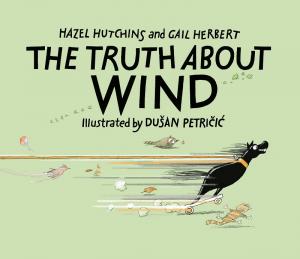
The Truth About Wind
The Truth About Wind is a powerful picture book for launching conversations about honesty. When Jesse sees the shiny wooden horse behind his backyard fence, he easily lets the people who accidentally left it flicker from his mind. Jesse pulls the horse through the fence by its string and names it Wind, the fastest horse in the world. Wind inspires fantastic make-believe adventures, but Jesse lies to his mother about Wind being a gift from grandma. Grandma calls, and Jesse changes the story to say Wind was from his other grandma. As the truth about Wind presents itself more and more in Jesse’s life, via lost horse posters and sightings of Wind’s actual owner, the illustrations metaphorically show the emotional tangle Jesse has created for himself. Wind’s pull string grows longer and twists around Jesse. Even after Jesse admits the truth to himself, he faces the tangle of how to explain it. His mother senses something is off, but is quietly supportive while allowing Jesse to solve his dilemma himself. When Jesse ultimately finds an opportunity to return the horse, he finds relief and shared joy in the owner’s happiness at the horse’s return. The Truth About Wind is a powerful picture book for launching conversations about honesty. When Jesse sees the shiny wooden horse behind his backyard fence, he easily lets the people who accidentally left it flicker from his mind. Jesse pulls the horse through the fence by its string and names it Wind, the fastest horse in the world. Wind inspires fantastic make-believe adventures, but Jesse lies to his mother about Wind being a gift from grandma. Grandma calls, and Jesse changes the story to say Wind was from his other grandma. As the truth about Wind presents itself more and more in Jesse’s life, via lost horse posters and sightings of Wind’s actual owner, the illustrations metaphorically show the emotional tangle Jesse has created for himself. Wind’s pull string grows longer and twists around Jesse. Even after Jesse admits the truth to himself, he faces the tangle of how to explain it. His mother senses something is off, but is quietly supportive while allowing Jesse to solve his dilemma himself. When Jesse ultimately finds an opportunity to return the horse, he finds relief and shared joy in the owner’s happiness at the horse’s return.
For Kindergarten students, this book is a valuable resource for learning about belonging and contributing, as well as developing early literacy skills in communicating feelings. Jesse’s thoughts and actions are highly relatable, and children will be bursting to share their own thoughts. Additionally, Jesse’s imaginative adventures with Wind are sure to inspire dramatic play. For grades 1 and 2, this is a strong selection for making inferences due to the depth of details added by the illustrations, which subtly show the cracks in Jesse’s story. For example, when “Jesse coaxed the horse with clover and dandelions to the safety of his backyard,” the horse wears a worried expression. These details also allow for rich point of view considerations. How would the story change if it were told by Wind or by the girl who lost him? This title also connects to Grade 1 social studies lessons about the impact that people can have on one another.
Katie VanArk is an associate member of ETFO.